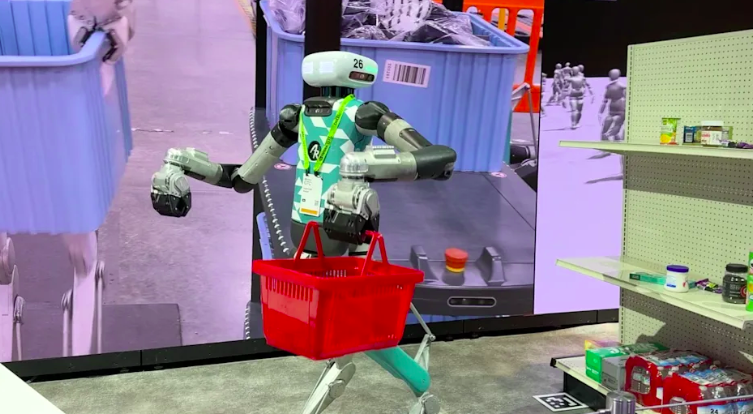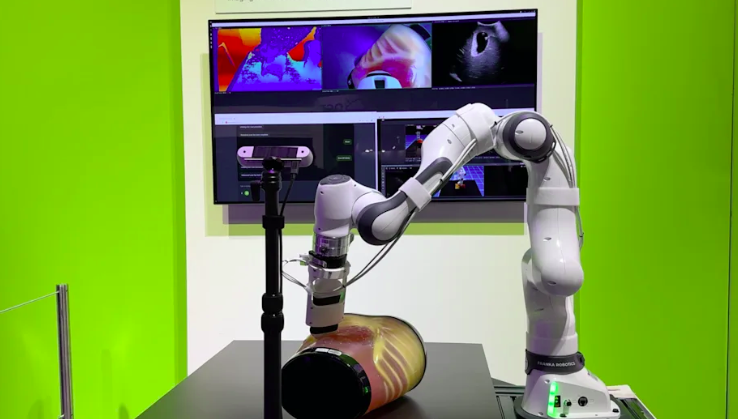While still riding the crest of the artificial intelligence wave with its coveted data center chips fueling giants like Amazon, Google, Meta, and Microsoft, Nvidia (NVDA) is strategically setting its sights on its next major growth frontier: robotics. Despite a slight dip in its stock year-to-date, Nvidia’s long-term performance remains robust, with revenue experiencing exponential growth. At the recent GTC event, CEO Jensen Huang passionately articulated the company’s vision for “physical AI,” encompassing autonomous vehicles and humanoid robots, leveraging Nvidia’s established digital AI prowess. With a decade of investment in this domain and a significant existing business, Nvidia anticipates robotics becoming one of its most substantial long-term ventures.

Nvidia (NVDA), a name synonymous with the current artificial intelligence revolution, continues to be the linchpin of cloud computing infrastructure. Its high-performance data center chips are in relentless demand by industry titans such as Amazon (AMZN), Google (GOOG, GOOGL), Meta (META), and Microsoft (MSFT), each vying for computational supremacy in the AI era.
Despite a modest 10% decline in its share price since the beginning of the year, Nvidia’s overall market trajectory remains undeniably upward. The stock has appreciated by an impressive 27% over the past year and an astounding 700% since 2023. This growth is mirrored in the company’s soaring revenues, which have catapulted from $27 billion in fiscal year 2023 to a projected $130 billion in fiscal year 2025.
However, the recent Nvidia GTC event served as a platform for CEO Jensen Huang to spotlight the company’s next ambitious endeavor: the realm of robotics. Huang envisions leveraging Nvidia’s established dominance in digital AI to cultivate what he terms “physical AI,” a domain encompassing technologies like self-driving vehicles and sophisticated humanoid robots.
During a press briefing at the conference, Huang emphasized the company’s decade-long commitment to this sector, stating, “We are … world class with robotic safety. I believe this expertise is going to pay off big someday.” He further elaborated, “We’ve been investing in this area for 10 years now. It’s a multibillion-dollar business for us already … and I think this is going to be one of the largest businesses for the company long term.”
Nvidia’s Foray into Physical AI
A walkthrough of Nvidia’s GTC exhibition at the San Jose McEnery Convention Center provided a tangible glimpse into the company’s burgeoning robotics ambitions. The showcase featured a diverse array of robotic innovations, ranging from intricate robotic arms performing delicate tasks to life-sized bipedal robots demonstrating complex movements.

Notably, Nvidia presented its own prototype of a robotic ultrasound machine, illustrating how various industries can harness its underlying technologies. This voice-activated bot featured a single, articulated mechanical arm equipped with a camera and scanner. Upon a verbal command to perform a liver scan, the robot swiftly located the organ on a training torso and executed the procedure. A display screen behind the setup showcased the real-time ultrasound imagery, offering a visual representation of the scanned organ.
Adjacent to Nvidia’s demonstration, Agility Robotics showcased its “Digit” robot. This agile automaton was observed repeatedly retrieving items from a simulated store shelf and placing them into a shopping basket, performing the task with tireless precision. The event also featured a collection of other advanced robotic arms and even a Boston Dynamics “Spot” quadruped robot.
A Tripartite System for Robotic Intelligence
Huang’s strategy hinges on the adoption by robot manufacturers of a comprehensive three-computer system developed by Nvidia for the training and operation of these intelligent machines.
The first element of this system comprises Nvidia’s DGX AI systems. These powerful computing platforms are intended for customers to utilize in the development and refinement of AI models specifically designed for robots.
The second component is the Nvidia Omniverse platform. This sophisticated simulation environment allows customers to train their robotic models to navigate and interact with the complexities of the real world within a virtual setting. The fundamental principle behind this approach is to enable rigorous testing of a robot’s AI in a vast array of potential scenarios – from navigating uneven terrain and avoiding obstacles to responding to unexpected events like falling objects – without exposing the robots, or their human counterparts, to any actual physical danger.
Rev Lebaredian, Nvidia’s vice president of Omniverse and simulation technology, explained to Yahoo Finance, “You want to simulate … millions of miles of [a car] driving, test it out beforehand, and then deploy it.” He further elaborated on the broader applicability: “And [it’s] the same for all robots. I’m using cars as an example, but the robots we have in our factories. These are multimillion-dollar factories. Any amount of downtime costs millions of dollars and opportunity cost, or they can be dangerous too. You don’t want them hurting the robots themselves or hurting people that are also in those factories.”
The final piece of the puzzle is Nvidia’s Jetson Thor onboard computer. This compact yet powerful processing unit is designed to run the pre-trained AI models directly on the robot itself, effectively serving as its “brain.” In the context of autonomous vehicles, Nvidia offers the AGX Thor, a similar onboard computer tailored for automotive applications.
Navigating Competition and Real-World Challenges
Nvidia is not alone in recognizing the immense potential of a future populated by intelligent robots. A host of other tech giants, including Amazon, Apple, Google, Meta, Microsoft, and Tesla, are also actively engaged in developing various aspects of the robotics ecosystem.
Furthermore, significant practical challenges remain before robots can seamlessly integrate into our daily lives. Humanoid robots, in particular, are still prohibitively expensive, often costing tens of thousands of dollars, and their battery life remains a significant limitation.
While the deployment of self-driving cars continues to expand to more urban areas, the widespread reality of fully autonomous personal transportation, where passengers can comfortably nap en route to their destinations, is still some time away.
However, Nvidia has a proven track record of persistent investment and development in technologies it believes in, ultimately leading to market breakthroughs. Its advancements in graphics processing and artificial intelligence capabilities stand as prime examples. If Nvidia can replicate this dedication and success within the field of robotics, it could unlock an entirely new and substantial growth opportunity for the chip manufacturing powerhouse.